July 25, 2024
Review RecipeEgg Custard Pie Recipe
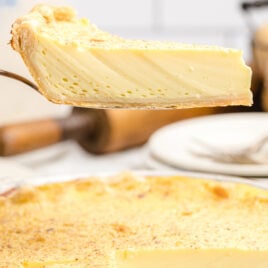
Table of Contents
Spaceships and Laser Beams has been a trusted source for delicious recipes for over a decade, and this custard pie is a guaranteed crowd-pleaser. This recipe is based on years of tweaking and perfecting to achieve the ultimate custard pie texture. We use simple ingredients you likely already have on hand, and my easy-to-follow instructions will guide you through each step.
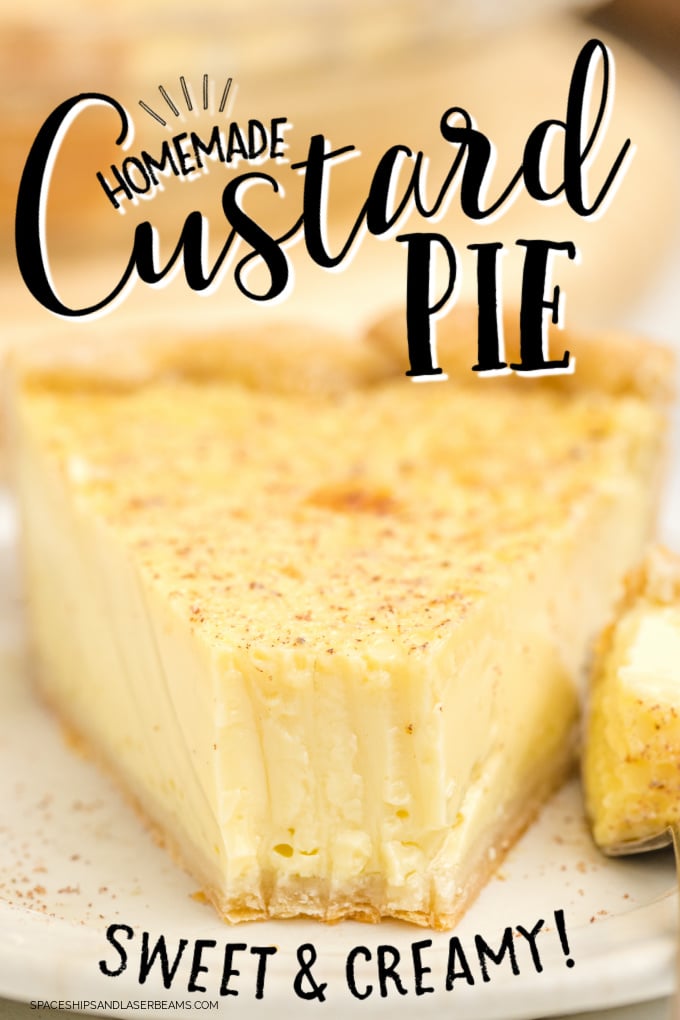
Everyone will love this Egg Custard Pie!
We know how important it is to have a reliable recipe, especially when baking. This custard pie recipe has been a hit with family and friends for years, and we are confident you’ll love it too! Plus, we’ve included some helpful tips and tricks along the way to ensure your pie turns out perfectly golden and delicious.
Custard Pie Recipe Ingredients

You’ll need:
- 1 unbaked pie crust
- 1 cup of sugar
- 6 large eggs, having them at room temperature is a must
- ¼ teaspoon of nutmeg
- 2 teaspoons of vanilla
- 3 cups of whole milk, having it at room temperature is a must
- ⅛ teaspoon of nutmeg, for garnish
How To Make Custard Pie
PREP: Ensure your eggs and milk are at room temperature.
STEP ONE: Preheat your oven to 350°F.
STEP TWO: Lightly spray a 9½-inch pie pan with nonstick spray.
STEP THREE: Place the unbaked pie crust in the pie pan, pressing the dough against the sides of the pie pan.
STEP FOUR: In a medium bowl, whisk together the sugar, room temperature eggs, ¼ teaspoon nutmeg, and vanilla for 2 minutes. Add room temperature milk and whisk the egg mixture for another 3 minutes until smooth.

What To Do If You Have Lumps in Your Custard Mixture
Straining the Mixture: The egg and milk mixture should be perfectly smooth before it’s added to the pie shell.
Even with careful whisking, it’s possible for small lumps or bits of coagulated egg to form. These lumps can give the baked custard a texture that’s reminiscent of scrambled eggs.
Straining the custard mixture can help to eliminate these lumps and ensure a perfectly smooth custard. Here’s how to do it:
- Prepare a sieve: Choose a fine-mesh sieve that’s large enough to hold your custard mixture. Place the sieve over a large bowl to catch the strained mixture.
- Pour the mixture: After you’ve whisked your eggs, sugar, and milk together, slowly pour the mixture into the sieve.
- Strain the mixture: Use a spatula or the back of a spoon to gently press on any solids or lumps that collect in the sieve. This will help to push the liquid portion of the mixture through the sieve and into the bowl, leaving the lumps behind.
- Check the mixture: Look at the mixture that’s collected in the bowl. It should be smooth and free of lumps. If you see any remaining solids, you may want to strain the mixture a second time to ensure it’s as smooth as possible.
- Use the strained mixture: Now that your custard mixture is perfectly smooth, you can pour it into your pie shell and proceed with the recipe as directed.
STEP FIVE: Pour the mixture into the pie shell.
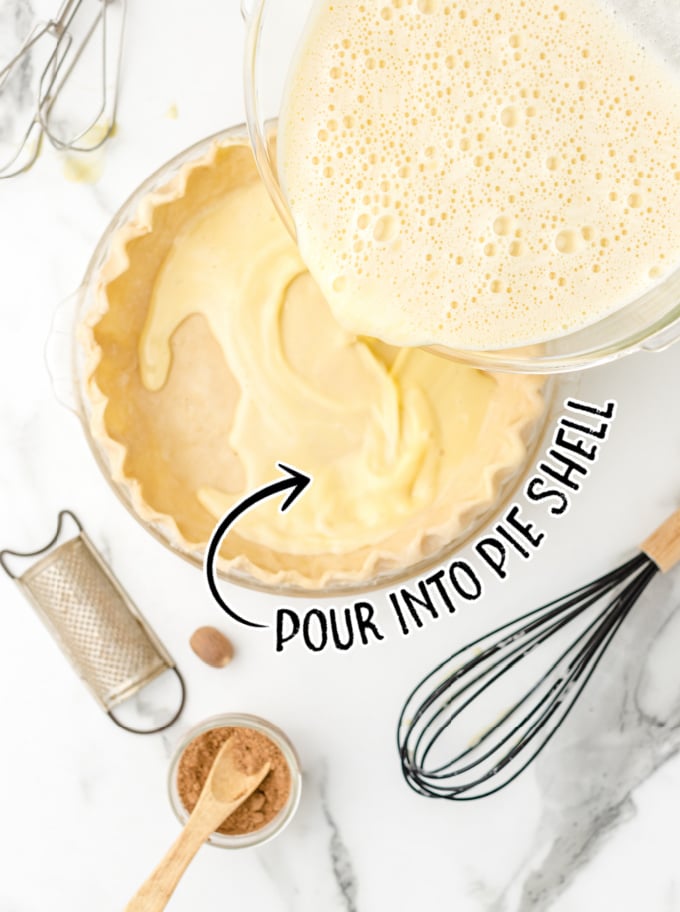
STEP SIX: Sprinkle the remaining ⅛ teaspoon of nutmeg lightly on top of the custard.
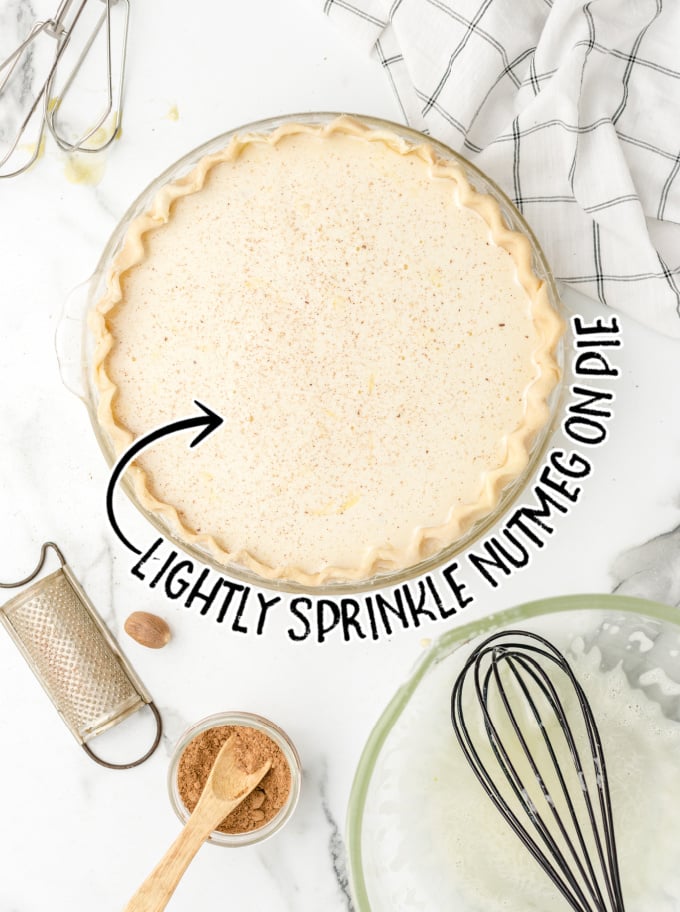
STEP SEVEN: Bake for 1 hour and 15 minutes or until set. Don’t overcook it.
Custard pies are delicate and can easily be overcooked. That’s because custard pies are unique in that they don’t solidify completely until they’ve cooled.
When they’re fully baked, they should still have a slight wobble, or “jiggle,” in the center when the pan is gently shaken. This is because the eggs in the custard continue to cook and set as the pie cools.
To perform the jiggle test, open the oven door and gently shake the pie pan by lightly holding one edge. Be careful not to jostle it too much, as this could cause cracks in your custard.
You’re looking for a slight jiggle in the very center of the pie. The outer edges of the pie should be mostly set and not wobble much, if at all.
If the entire pie jiggles a lot, or if it sloshes around, it’s not done yet and needs more time in the oven. If there’s no jiggle at all, the pie may be overcooked, which can result in a texture that’s more like scrambled eggs than creamy custard.
Remember, it’s better to err on the side of slightly undercooking a custard pie. As it cools, the residual heat will continue to cook the custard to the perfect consistency.
PRO TIP:
You’ll be able to tell when your custard pie is done by doing a simple jiggle test. Try gently shaking the pie pan and if the center of the pie jiggles slightly, it’s done!
STEP EIGHT: Slice and serve. This pie tastes and cuts best when chilled.
Custard Pie substitutions
EVAPORATED MILK: I’ve seen some egg custard pie recipes made with evaporated milk or heavy cream. This makes the custard filling even richer. Feel free to substitute this for regular milk if you like your custard extra creamy and sweet.
PIE CRUST: You can either use a store-bought crust or you can make your own pie crust. Check out our favorite pie crust recipe here.
Egg Custard Pie Recipe Tips
When preparing a custard pie, it’s crucial to use room-temperature eggs and milk. Room-temperature ingredients blend more seamlessly, creating a smoother, more homogeneous mixture.
This is particularly important for a custard pie, where achieving a silky, smooth texture is key. Additionally, room-temperature eggs and milk contribute to even cooking, preventing the issue of an unevenly baked pie that’s overcooked on the edges and undercooked in the center.
Remember, baking is a science that requires precision. Small details, like the temperature of your ingredients, can significantly impact the final result.
So, for the perfect custard pie, take the extra time to bring your eggs and milk to room temperature before starting your recipe. This simple step can make the difference between a good pie and a great one.
How To Serve Egg Custard Pie
Homemade pies are so much better than store-bought, and this old-fashioned custard pie is no exception. Because of its light texture and sunny yellow color, it is an ideal summer dessert.
Add a bit of whipped cream on top of the pie and fresh berries, and a scoop of vanilla ice cream on the side.
For another custard recipe, check out our cream puff dessert, which is filled with a yummy custard inside a flaky puff pastry and topped with chocolate and whipped cream.
Our magic custard cake is truly amazing in the way the layers separate while baking.
For more delicious pie recipes, check out our jello pie, peanut butter pie, and chocolate pudding pie.
Egg Custard Pie Recipe Storage
IN THE FRIDGE: If you have leftovers, the cream pie will stay fresh, covered in plastic wrap or aluminum foil, in the refrigerator for 2-3 days. It’s best served cold.
IN THE FREEZER: This classic custard pie is ridiculously silky and creamy when it is freshly baked, but unfortunately, it is not one of those desserts you can freeze, defrost and enjoy later.
As with most dishes that contain dairy, when it is defrosted, the ingredients separate, and you lose that rich silky goodness that makes this recipe to die for!
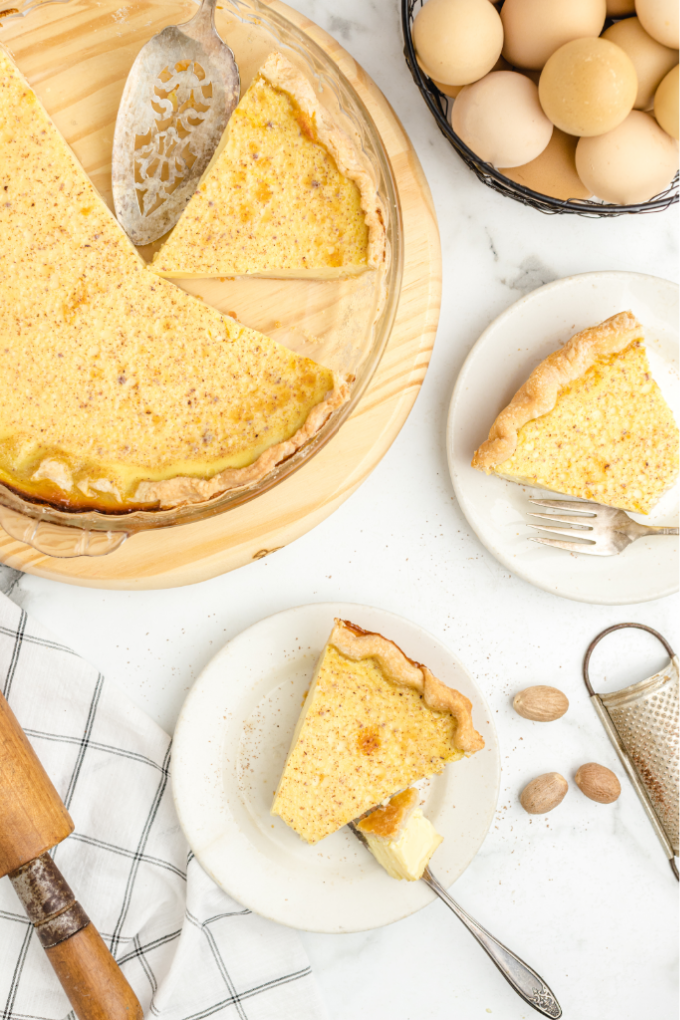
Easy Custard Pie Recipe FAQ
If you don’t have a 9.5-inch plate, a 9-inch pie plate will work just fine.
Egg custard pie and custard pie are two names for the same delicious, creamy type of pie.
Egg custard pie has a velvety texture and sweet and creamy flavor.
You’ll know your custard pie is finished baking when the edges of the custard are firm and the center jiggles slightly.
A custard pie can be overbaked. Properly baked, the custard will just be barely set once finished, whereas overbaking will result in a soggy crust and scrambled eggs.
A properly baked custard pie should have a slight jiggle to it.
A custard pie can be runny if there is too much milk or the eggs have been undercooked. You can solve the problem by adding a thickener in the form of a cornstarch slurry.
Common varieties of custard pie include Chess Pie, Buttermilk Pie, and Pumpkin Pie.
More Recipes You’ll Love

Easy Custard Pie Recipe
Ingredients
- 1 unbaked pie crust
- 1 cup sugar
- 6 large eggs room temperature
- 2 teaspoons vanilla
- ¼ teaspoon nutmeg
- 3 cups whole milk room temperature
- ⅛ teaspoon nutmeg, garnish
Instructions
- Preheat oven to 350°F.
- Lightly spray a 9½-inch pie pan with nonstick spray.
- Place unbaked pie crust in pie pan, pressing dough against the sides of the pie pan.
- Whisk together sugar, eggs, ¼ teaspoon nutmeg, and vanilla for 2 minutes. Add milk and whisk for another 3 minutes until smooth.
- Pour mixture into pie shell.
- Sprinkle the remaining ⅛ teaspoon nutmeg lightly on top of the custard.
- Bake for 1 hour and 15 minutes or until set.
- Slice and serve.
Video
Notes
- Using room-temperature eggs and milk help with even cooking.
- You’ll be able to tell when it’s done by doing a simple jiggle test. Try gently shaking the pie pan, and if the center of the pie jiggles slightly, it’s done!
- This pie tastes and cuts best when chilled.
- The eggs and milk should be at room temperature before baking. You’ll be able to tell when it’s done by doing a simple jiggle test. Try gently shaking the pie pan, and if the center of the pie jiggles slightly, it’s done!
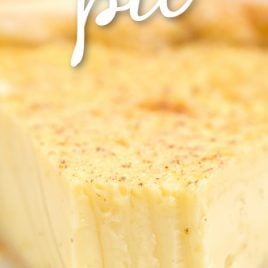
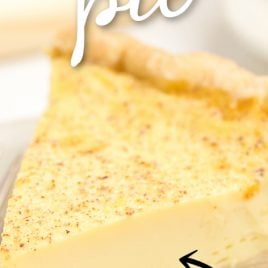



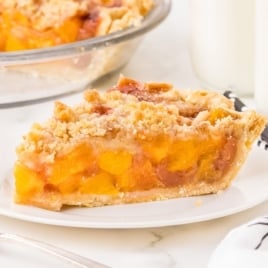
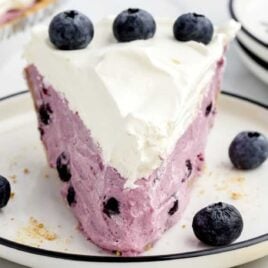
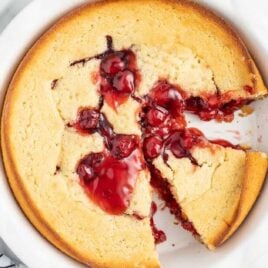

Comments
cora says
I can’t seem to Download the recipe. Can I have a printout?
Layne Kangas says
Hi, Cora – you can use the printable recipe card at the bottom of the post to easily print a formatted recipe to save as a PDF or print. Enjoy!
Susan Ferranti says
I love your recipes. Thank you for sharing
Terry Schoeppe says
The best custard pie I have made!
Terry Schoeppe says
One thing I did different this time, I have read so many recipes, one said to avoid a soggy crust, whisk about a half of an egg white and paint your crust before you fill it. I had no soggy bottom!
Val says
DELICIOUS!! 😋😋
Judy says
I love your recipes and can’t wait to try them out.
Thank you for sharing 🤗🤗
Judy
Lynda says
Awesome,and delicious 😋 Making sure egg and Milk is at room temp, is the key.